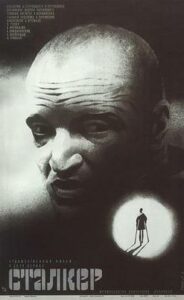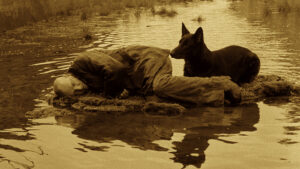Tarkovsky’s “Stalker” – a film about the desire for the sacred

Title: “Stalker”
Release Date: 1979
Director: Andrei Tarkovsky
Cast: Aleksandr Kaydanovskiy, Anatoli Solonitsyn, Nikolay Grinko, Alisa Freyndlikh, Natasha Abramova
Andrei Tarkovsky is one of the greatest Russian directors, and “Stalker”, along with “Andrei Rublev” and “Mirror”, is one of his most important works. This story, based on the patterns of science-fiction cinema, is rich in deep mystical senses. It is both a harsh criticism of the maximally sterilized industrial civilization and a diagnosis of the condition of modern man, locked in his spiritual blindness.
“Stalker” means guide
“Stalker” is loosely based on the Strugatsky brothers’ novel “Roadside Picnic” (1972). It was from this book that Tarkovsky took the idea for the title character. In Strugatsky’s work, Stalkers are guides to Zona, a zone haunted by aliens and isolated from human civilization due to contamination. In the film, the Zone is an area in which the known laws of physics do not operate, and the space-time continuum changes depending on the state of mind of the people who visit it. The title “Stalker” (played by Aleksandr Kaydanovskiy) organizes expeditions to this mysterious region in defiance of the official ban by the authorities to visit the Zone. One day he is to hike with the Writer (Anatoli Solonitsyn) and the Professor (Nikolay Grinko), prominent representatives of science and art.
The men have to overcome many obstacles to reach Zona: to confuse the vigilant guards and escape deadly gunfire. Their destination is the wondrous Chamber, where their most secret desires come true. To reach it, they must follow Stalker’s instructions. The man determines the route, throwing in front of them nuts wrapped in bandages, which serve as magical amulets protecting them from loss. It turns out that the Zona at any time can kill uninvited guests, if he considers that they break the rules in force in it.

Along the way, Stalker has to tame his customers’ wilfulness. The writer intends to go his own way and the Professor, despite Stalker’s admonitions, returns for his backpack. Eventually they reach their destination and stand at the threshold of the Chamber, which, according to Stalker, means that they are people of high moral values. It is then revealed that the Professor has brought a bomb with him to blow up the Chamber and thus prevent the potential wicked from fulfilling their demonic dreams. What’s more, to Stalker’s despair, the Writer is intent on helping the Professor fulfill his intentions. Subsequent shots, however, show the three of them in the café from which they set out. Stalker returns to his wife and disabled mutant daughter (the girl does not walk because she is the offspring of a man linked to Zona). As the hero falls asleep, his wife delivers a sad monologue about the role of suffering in human life. In the final shot, to the sounds of Bethoveen’s Ninth Symphony, we see Stalker’s daughter, who unexpectedly reveals paranormal abilities.
“Stalker” – rich in religious symbolism
“Stalker” is a movie rich in various references and quotations from European culture. Tarkovsky draws primarily on religious symbolism. He references the Bible, Taoism, Russian mysticism, and religious painting. Zona itself resembles the biblical Eden, guarded by the Angel of Death. Such meanings are already suggested by the film’s cinematography. We are dealing here with a clear division: the first part of “Stalker” was shot in a bizarre, sepia-like color scheme that brings to mind expressionist, deformed landscapes (a clear negative valuation of the flat, colourless world). The shots of Zona, on the other hand, are striking with their expressive, vivid colors, especially green. Before entering the Chamber, the colors of the frames turn to symbolic gold.
The journey through Zona becomes an allegorical journey of life, but it also resembles the journey of two disciples to Emmaus, discussing important matters among themselves and unaware of the presence of Christ. Stalker himself bears clear messianic traits: he refers primarily to the figure of Jesus – as a shepherd (the motif of the dog the hero takes in), teacher, guide, and savior. The latter incarnation of Stalker is emphasized, for example, by the crown of thorns found in front of the Chamber, alluding to the Passion and Resurrection. The figure of Stalker is also a reference to the Russian folk tradition of the divine husband – a man chosen and endowed with special spiritual attributes.

The motif of immersion in water at the end of the journey recalls the symbolism of baptism. Moreover, the positioning of the figures in the café scene is a reference to Andrei Rublev’s famous icon The Holy Trinity, and the shot of Stalker carrying his daughter on his shoulders alludes to St. Christopher.
Less than a decade after Tarkovsky’s film, the word “stalker” will gain new meanings: this is the name given to looters illegally entering the Chernobyl zone, contaminated after the explosion of the nuclear reactor.
“Stalker” – the barren land of modern civilization
Tarkovsky’s “Stalker” clearly builds a world based on the contrast between the repulsive industrial civilization (the landscape is dominated by factories and smokestacks poisoning the environment) and the pure, beautiful Zona, where nature in a way cleanses the space-time continuum from the contamination caused by humans. Nevertheless, this contamination is also metaphorical – the barren land – as in Thomas Eliott’s work – becomes a synonym for dead spirituality. Modern man appears here as a being hollowed out of all faith, but also hope.
Therefore, “Stalker” becomes a plea for faith in love capable of changing the face of reality. The message of the film is not entirely pessimistic: the Writer and the Poet did not blow up the Chamber after all – they did not dare to enter it, lest they stand in truth and have to face their deepest, perhaps unconscious, desire. Stalker’s family, especially his daughter, is also a sign of hope. For beneath her physical disability lies the great power of supernatural abilities (the girl uses her mind to manipulate objects at will). This message is commented on by a fragment of Ludwig Bethoveen’s Symphony No. 9, a perfect work of art created by a man completely deprived of hearing. Therefore, suffering has a hidden meaning in Tarkovsky’s work, which is best explained by the words taken from Taoism heard by Stalker in Zona: “weakness is great and strength is nothing. At birth a man is weak and flabby, at death – hard and rigid. (…) That which is hardened will never win”.
Literature:
A.Garbicz, “Kino, wehikuł magiczny. Przewodnik osiągnięć filmu fabularnego. Podróż piąta 1974 – 1981”, Kraków 2009.

